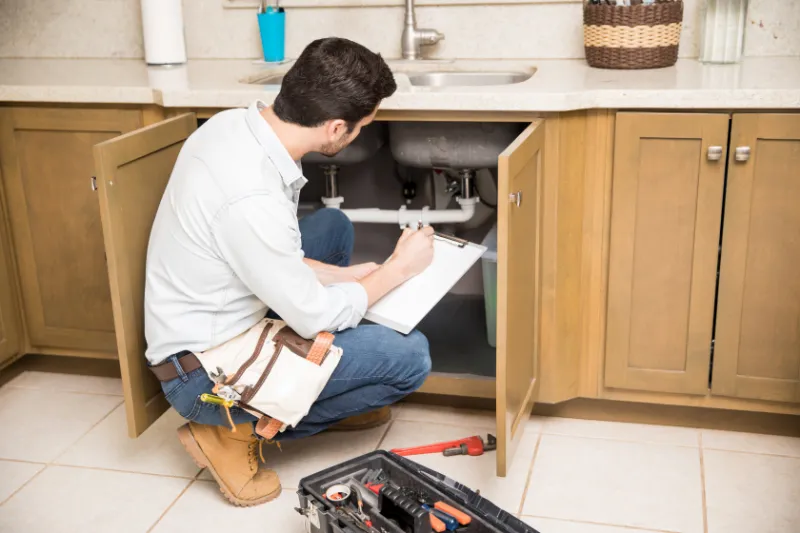Contents
Are you wondering what a rough-in for a faucet is and why it’s important? Look no further! In this article, we’ll explain everything you need to know about roughing-in a faucet.
From the components involved to the steps to perform it, we’ve got you covered. Avoid common mistakes and reap the benefits of a properly executed rough-in.
Get ready to tackle your faucet installation like a pro!
Key Takeaways
- A proper rough-in is essential for the functionality and durability of a faucet.
- Incorrect rough-in can lead to issues like leaks, low water pressure, and damage to walls and fixtures.
- Proper rough-in ensures a smooth and efficient installation process, avoiding leaks and water damage.
- Professional assistance for faucet rough-in is important to ensure proper installation, adherence to plumbing codes, and access to specialized tools and equipment.
Importance of Rough-In for Faucet Installation
What is a basic plumbing rough in? When installing a faucet, it’s important to understand the significance of the rough-in, as it serves as the foundation for the entire installation process. The rough-in refers to the initial plumbing work that’s done behind the walls before the actual faucet is installed. It involves preparing the necessary water supply lines and ensuring that they’re properly connected to the main water source.
The rough-in stage is crucial because it determines the functionality and durability of the faucet. If the rough-in isn’t done correctly, you may encounter issues such as leaks, low water pressure, or even damage to the surrounding walls and fixtures. By taking the time to ensure a proper rough-in, you can avoid these problems and ensure a smooth and efficient installation process.
During the rough-in, it’s important to measure and mark the placement of the faucet, as well as any other fixtures that will be installed. This will help ensure that everything is aligned properly and looks aesthetically pleasing. Additionally, it’s essential to use the right materials and follow the manufacturer’s instructions for the rough-in process. This will help guarantee that the faucet functions properly and meets all safety standards.
Components Involved in a Faucet Rough-In
To complete a faucet rough-in, you will need several key components. These components are essential for a successful installation and ensure that your faucet functions properly. Let’s take a look at the components involved in a faucet rough-in:
| Component | Description |
|---|---|
| Supply Lines | These are flexible tubes that connect the faucet to the water supply. They come in different lengths and materials, such as stainless steel or braided nylon. Make sure to choose the right size and material for your specific installation. |
| Shut-off Valves | These valves control the water flow to the faucet. They are typically located under the sink or behind the wall and allow you to shut off the water supply in case of emergencies or repairs. There are different types of shut-off valves, including compression, ball, and gate valves. |
| Rough-In Valve | This valve is the heart of the faucet system. It controls the water temperature and pressure. The rough-in valve is usually installed during the construction phase and connects to the hot and cold water supply lines. It is important to choose a high-quality rough-in valve to ensure long-lasting performance. |
| Mounting Hardware | This includes all the necessary screws, nuts, and brackets to secure the faucet to the sink or countertop. The mounting hardware ensures that the faucet remains stable and prevents any leaks or wobbling. |
These components work together to provide a functional and reliable faucet system for your home. When installing a faucet, it is crucial to choose high-quality components that are compatible with your plumbing system. By using the right components and following the proper installation process, you can enjoy a well-functioning faucet that serves you and your family for years to come.
Steps to Perform a Faucet Rough-In
To perform a faucet rough-in, you’ll need to follow a series of steps that ensure a proper installation and functioning of the faucet system. Here are the steps you should take:
- Prepare the Work Area
- Clear the space around the sink to make room for your tools and materials.
- Turn off the water supply to avoid any accidents or leaks during the installation process.
- Remove the Old Faucet
- Use a wrench or pliers to disconnect the water supply lines from the old faucet.
- Unscrew the nuts securing the faucet to the sink and remove it carefully.
- Install the Rough-In Valve
- Position the rough-in valve according to the manufacturer’s instructions.
- Secure the valve to the wall using screws or brackets.
- Attach the Water Supply Lines
- Connect the water supply lines to the rough-in valve, ensuring they’re tightly secured.
- Make sure to use the appropriate fittings and connectors for a leak-free connection.
- Mount the Faucet Trim
- Slide the escutcheon plate onto the valve and position it against the wall.
- Secure the trim to the valve using the provided screws.
- Test the Faucet
- Turn on the water supply and check for any leaks.
- Operate the faucet handles to ensure smooth and proper functioning.
Common Mistakes to Avoid During a Faucet Rough-In
To ensure a smooth faucet rough-in, it is important to be aware of common mistakes to avoid during the installation process. By understanding these mistakes and taking preventative measures, you can save yourself time, money, and frustration. Here are some common errors to watch out for:
| Mistake | Description | Prevention |
|---|---|---|
| Incorrect measurements | Failing to measure accurately can lead to misaligned faucets and leaks. | Double-check all measurements before cutting or installing any components. Use a tape measure and level for precise measurements. |
| Poor sealing | Inadequate sealing can cause leaks and water damage. | Use high-quality plumbers tape or thread sealant to ensure a tight seal. Follow the manufacturer’s instructions for proper application. |
| Over-tightening | Applying too much force when tightening connections can damage the faucet or cause leaks. | Use a wrench or pliers to tighten connections, but be careful not to overtighten. Stop when you feel resistance to avoid damaging the fittings. |
| Incorrect pipe placement | Placing pipes too close together or at the wrong angle can restrict water flow and cause leaks. | Follow plumbing codes and guidelines for proper pipe placement. Ensure proper spacing between pipes and use appropriate fittings for angles and turns. |
Benefits of Properly Executed Faucet Rough-In
By properly executing a faucet rough-in, you can ensure optimal functionality and longevity for your faucet. Here are some benefits of a well-executed faucet rough-in:
- Avoids leaks and water damage:
When the rough-in is done correctly, it minimizes the risk of leaks. Properly sealed connections and secure installation prevent water from seeping into walls or floors, preventing costly water damage. - Enhanced efficiency:
A properly executed faucet rough-in ensures that the water flow is smooth and uninterrupted. This allows for efficient water usage, reducing wastage and saving you money on your water bill. - Improved water pressure:
A well-executed rough-in ensures that water flows at the desired pressure, giving you a satisfying and consistent stream of water. - Proper drainage:
Correctly aligned rough-in allows for effective draining of water, preventing any pooling or stagnant water that can lead to unpleasant odors and hygiene issues. - Extended lifespan:
A faucet rough-in that’s done properly ensures that the faucet is securely installed, reducing the risk of premature wear and tear. This extends the lifespan of your faucet, saving you money on frequent replacements. - Saves time during installation:
When the rough-in is executed correctly, it makes the installation process smoother and faster. This is especially beneficial if you’re hiring a professional plumber, as it reduces their time on the job and saves you money on labor costs. - Allows for easy upgrades:
A well-executed faucet rough-in provides flexibility for future upgrades or changes. If you decide to replace your faucet or upgrade to a different style, a properly executed rough-in makes the process much easier and more straightforward.
Conclusion
In conclusion, a rough-in for a faucet is a crucial step in the installation process. It involves setting up the necessary components and ensuring proper measurements for the faucet.
By following the correct steps and avoiding common mistakes, a properly executed rough-in can provide numerous benefits, such as ensuring a secure and efficient faucet installation.
So, make sure to pay attention to this important step to achieve a successful faucet installation.




